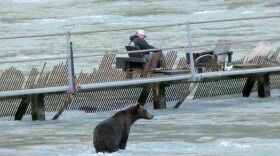-
Surplus then shortage, low weights, farm fish, imports, lower demand contribute to tangle of challenges.
-
Biologists from Oregon Department of Fish and Wildlife and The Klamath Tribes have discovered several salmon in a tributary of the Klamath River in Oregon, above the site of four dams that were removed earlier this year.
-
The move to remove the dams marks a major victory for tribes in the region who fought for decades to free hundreds of miles of the Klamath River.
-
The weirs in Alaska’s rivers and elsewhere are crucial tools for managing fisheries.
-
The U.S. government recently recognized the harm caused by the dams and has promised to work to restore salmon runs but tribal members doubt much will change.
-
For the first time in more than a century, salmon will have free passage along the more than 400 miles of the Klamath River and its tributaries.
-
As salmon and steelhead swim upstream, they’re now facing one more challenge in fish ladders. It’s a non-native fish competing for space: the American shad.
-
The U.S. government has acknowledged the harmful effects dams have had on tribal fisheries. OPB reporter Tony Schick found that some of these actions were deliberate.
-
The new agreement will help manage the waterways for the next 20 years, with an emphasis on ecosystem improvement and collaboration with U.S. tribes and Canadian First Nations.
-
Size is a strength, and the economic value of the industry rose in 2021 and 2022, but employment is declining and recent price collapses are worrisome, the report says.
Play Live Radio
Next Up:
0:00
0:00
Available On Air Stations










